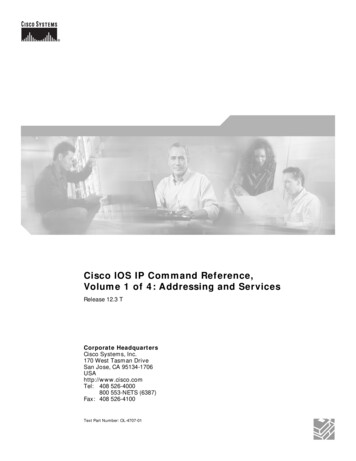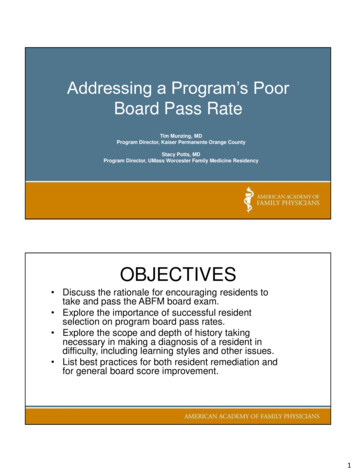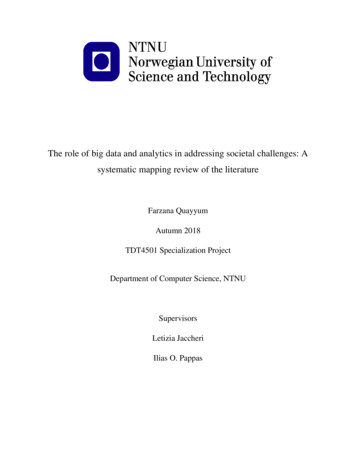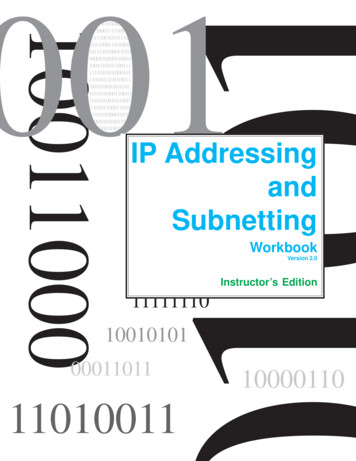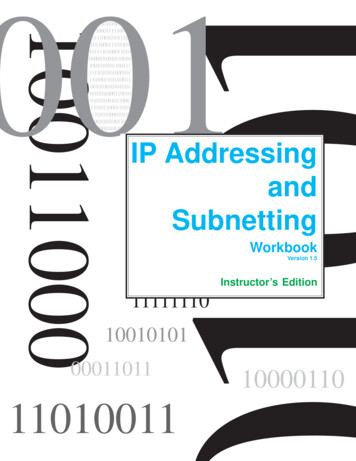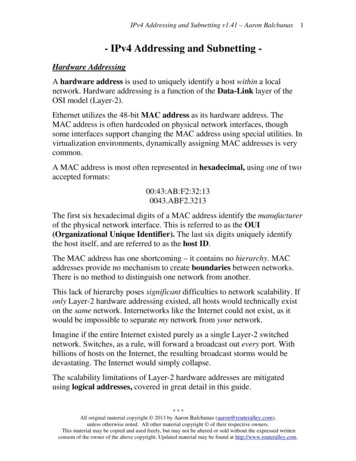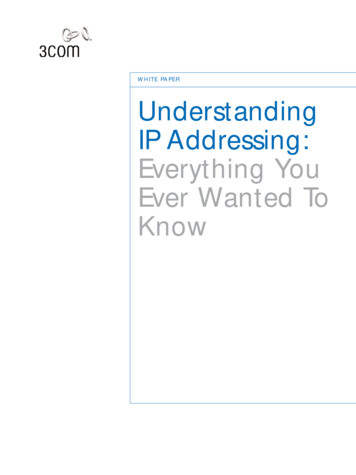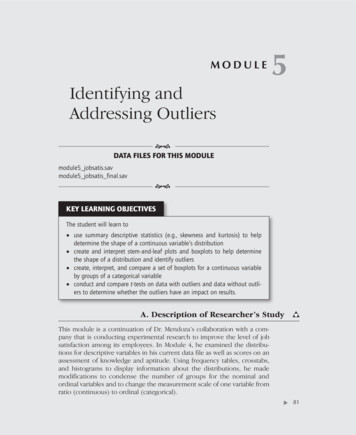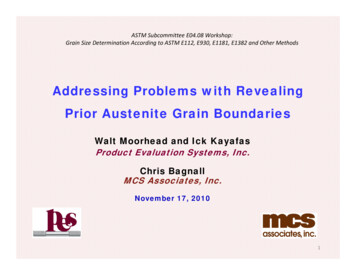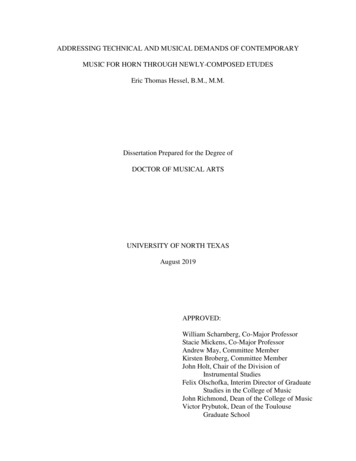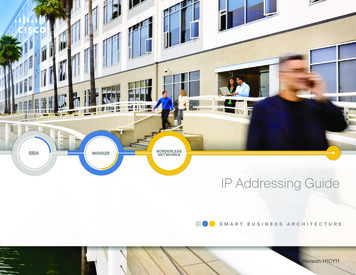
Transcription
IP Addressing GuideRevision: H1CY11
The Purpose of This GuideThe reader may require any of the following: A general understanding of IP addressing and subnetting General IP addressing guidance while redesigning an existing network Guidance on how to add new services to an existing network Assistance planning for the acquisition of a company that has a differentIP address spaceThis guide introduces you to the basics of IP addressing and prepares youto create an IP addressing plan for your network. A plan for expansion after running out of IP address spaceThis guide is a concise reference on IP addressing best practices, including: The basic concepts of IP addressing An IP address migration path for growth An IP addressing plan that can be used in midsize networks as a template for customer deployments The IP addressing plan used in the Cisco Smart Business Architecture(SBA) Foundation lab networkBefore reading this guide The steps you should follow to create your own IP Addressing Plan How to maintain your IP space as your network evolvesFoundation Design OverviewWho Should Read This GuideThis guide is intended for the reader with any or all of the following:Foundation Deployment Guide An organization with up to 2500 connected employees Up to 75 remote sites with approximately 25 employees eachFoundation Configuration Files Guide IT workers with a CCNA certification or equivalent experienceDesign GuidesYou are HereDeployment GuidesIPv4 AddressingIPv6 AddressingSupplemental GuidesFoundationConfigurationFilesThe Purpose of This Guide
Table of ContentsIntroduction. . . . . . . . . . . . . . . . . . . . . . . . . . . . . . . . . . . . . . . . . . . . . . . . . . . . . . . . . . . . . . . . 1Guiding Principles. . . . . . . . . . . . . . . . . . . . . . . . . . . . . . . . . . . . . . . . . . . . . . . . . . . . . . . 1Managing IP Addresses . . . . . . . . . . . . . . . . . . . . . . . . . . . . . . . . . . . . . . . . . . . . . . . . . . . 8IP Addressing in the Smart Business Architecture . . . . . . . . . . . . . . . . . . . . . . 8IP Addressing Overview. . . . . . . . . . . . . . . . . . . . . . . . . . . . . . . . . . . . . . . . . . . . . . . . . . . 2Appendix A: Subnet Design Worksheet for SBA . . . . . . . . . . . . . . . . . . . . . . . . . 16IP Addressing Basics. . . . . . . . . . . . . . . . . . . . . . . . . . . . . . . . . . . . . . . . . . . . . . . . . . . . . . 3IP Address Classes. . . . . . . . . . . . . . . . . . . . . . . . . . . . . . . . . . . . . . . . . . . . . . . . . . . . . . 3Appendix B: SBA for Midsize Organizations Document System. . . . . . . . . . 17Private IP Addressing . . . . . . . . . . . . . . . . . . . . . . . . . . . . . . . . . . . . . . . . . . . . . . . . . . . 4Subnetting . . . . . . . . . . . . . . . . . . . . . . . . . . . . . . . . . . . . . . . . . . . . . . . . . . . . . . . . . . . . . . 4Variable Length Subnet Masks (VLSMs) . . . . . . . . . . . . . . . . . . . . . . . . . . . . . . . . . 5Voice Overlay Subnets. . . . . . . . . . . . . . . . . . . . . . . . . . . . . . . . . . . . . . . . . . . . . . . . . . . 5Summarization. . . . . . . . . . . . . . . . . . . . . . . . . . . . . . . . . . . . . . . . . . . . . . . . . . . . . . . . . . . 6IP Multicast . . . . . . . . . . . . . . . . . . . . . . . . . . . . . . . . . . . . . . . . . . . . . . . . . . . . . . . . . . . . . . 6ALL DESIGNS, SPECIFICATIONS, STATEMENTS, INFORMATION, AND RECOMMENDATIONS (COLLECTIVELY, "DESIGNS") IN THIS MANUAL ARE PRESENTED "AS IS," WITH ALL FAULTS. CISCO AND ITS SUPPLIERSDISCLAIM ALL WARRANTIES, INCLUDING, WITHOUT LIMITATION, THE WARRANTY OF MERCHANTABILITY, FITNESS FOR A PARTICULAR PURPOSE AND NONINFRINGEMENT OR ARISING FROM A COURSE OFDEALING, USAGE, OR TRADE PRACTICE. IN NO EVENT SHALL CISCO OR ITS SUPPLIERS BE LIABLE FOR ANY INDIRECT, SPECIAL, CONSEQUENTIAL, OR INCIDENTAL DAMAGES, INCLUDING, WITHOUT LIMITATION, LOST PROFITS OR LOSS OR DAMAGE TO DATA ARISING OUT OF THE USE OR INABILITY TO USE THE DESIGNS, EVEN IF CISCO OR ITS SUPPLIERS HAVE BEEN ADVISED OF THE POSSIBILITY OF SUCHDAMAGES. THE DESIGNS ARE SUBJECT TO CHANGE WITHOUT NOTICE. USERS ARE SOLELY RESPONSIBLE FOR THEIR APPLICATION OF THE DESIGNS. THE DESIGNS DO NOT CONSTITUTE THE TECHNICALOR OTHER PROFESSIONAL ADVICE OF CISCO, ITS SUPPLIERS OR PARTNERS. USERS SHOULD CONSULT THEIR OWN TECHNICAL ADVISORS BEFORE IMPLEMENTING THE DESIGNS. RESULTS MAY VARYDEPENDING ON FACTORS NOT TESTED BY CISCO.Any Internet Protocol (IP) addresses used in this document are not intended to be actual addresses. Any examples, command display output, and figures included in the document are shown for illustrative purposesonly. Any use of actual IP addresses in illustrative content is unintentional and coincidental. Cisco Unified Communications SRND (Based on Cisco Unified Communications Manager 7.x) 2010 Cisco Systems, Inc. All rights reserved.Table of Contents
SBA OverviewGuiding PrinciplesWe divided the deployment process into modules according to the followingprinciples: Ease of use: A top requirement of Cisco SBA was to develop a designthat could be deployed with the minimal amount of configuration andday-two management.The Cisco Smart Business Architecture (SBA) is a comprehensive designfor networks with up to 2500 users. This out-of-the-box design is simple,fast, affordable, scalable, and flexible. There are three options based on yourscaling needs: up to 600 users, 1000 users, and up to 2500 users. Cost-effective: Another critical requirement as we selected productswas to meet the budget guidelines for midsize organizations.The Cisco SBA for Midsize Organizations incorporates LAN, WAN, wireless,security, WAN optimization, and unified communication technologies testedtogether as a solution. This solution-level approach simplifies the systemintegration normally associated with multiple technologies, allowing youto select the modules that solve your organization’s problems rather thanworrying about the technical details. Reuse: We strived, when possible, to reuse the same products throughoutthe various modules to minimize the number of products required for spares. Flexibility and scalability: As the organization grows, so too must itsinfrastructure. Products selected must have the ability to grow or berepurposed within the architecture.We have designed the Cisco Smart Business Architecture to be easy toconfigure, deploy, and manage. This architecture:UserServices Provides a solid network foundation Makes deployment fast and easy Accelerates ability to easily deploy additional services Avoids the need for re-engineering of the core networkNetworkServicesVoice,Video,Web MeetingsSecurity,WAN Optimization,Guest AccessBy deploying the Cisco Smart Business Architecture, your organization can gain: A standardized design, tested and supported by Cisco. Optimized architectures for midsize organizations with up to 2500 users. WAN with up to 75 remote sites with a headquarters site, regional site,and approximately 25 users per remote site. Flexible architecture to help ensure easy migration as the organization grows. Seamless support for quick deployment of wired and wireless networkaccess for data, voice, teleworker, and wireless guest. Security and high availability for corporate information resources,servers, and Internet-facing applications. Improved WAN performance and cost reduction through the use of WANoptimization.NetworkFoundationRouting, Switching,Wireless, and InternetThe Cisco Smart Business Architecture can be broken down into the following three primary, modular yet interdependent components for the midsizeorganization. Network Foundation: A network that supports the architecture Network Services: Features that operate in the background to improveand enable the user experience without direct user awareness User Services: Applications with which a user interacts directly Simplified deployment and operation by IT workers with CCNA certification or equivalent experience. Cisco enterprise-class reliability in products designed for midsizeorganizations.Introduction1
IP Addressing OverviewAn IP address uniquely identifies a device on an IP network.Allocating, recycling, and documenting IP addresses and subnets in a network can get confusing very quickly if you have not laid out an IP addressingplan. A sound plan will help you prepare the network foundation to supportadditional services such as unified communications, wireless access, andenhanced network security.IP addressing is a Network Foundation service, which makes it core to thenetwork design. It provides the base for all other network and user services.Without the foundation, it would not be possible to interact with network anduser services, from picking up the phone using the phone service to readingemail using the email service.By following recommended IP address management standards, you canavoid: Overlapping or duplicate subnets Unsummarized routes in the network Duplicate IP address device assignments Wasted IP address space Unnecessary complexityIP Addressing Overview2
IP Addressing BasicsIP version 4 (IPv4) addresses, which uniquely identify a device on an IPnetwork, are 32 bits in length and are typically communicated in a formatknown as dotted decimal.The 32 binary bits are: Divided into a network portion and host portion Broken into four octets (1 octet 8 bits). Each octet can be converted tobinary.Class A has 3 octets for the host portion of the address. Deployed as is, aClass A address represents a very inefficient use of address space, sinceavailable Layer 2 technologies cannot easily support this many hosts on asingle subnet. Subnetting uses this address space efficiently.Tech TipIP version 6 (IPv6) is the next generation of IP addressing. IPv6quadruples the number of network address bits from 32 bits (in IPv4)to 128 bits, which provides enough globally unique IP addresses forevery networked device on the planet. IPv6 is an important protocolfor the future of IP networking. More information can be found atwww.cisco.com/go/ipv6.Consider this IP address, which is presented in dotted decimal: 10.10.16.1.The address breaks down into the following octets: 10Figure 1. Classful Addresses01230 1 2 3 4 5 6 7 0 1 2 3 4 5 6 7 0 1 2 3 4 5 6 7 0 1 2 3 4 5 6 7 10 16Class AIP Address ClassesIP addresses are split up into several different categories, including Class A,B, C, D (Multicast), and E (Reserved).Address classes are defined, in part, based on the number of bits that makeup the network portion of the address, and in turn, on how many are left forthe definition of individual host addresses. In Class A addresses, the first octet is the network portion.24 bits (Node ID)1.0.0.0 – 127.255.255.255Net ID 1The value in each octet ranges from 0 to 255 decimal, or 00000000–11111111 binary. In binary, the address 10.10.16.1 is represented as: 00001010.00001010.00010000.00000001.001230 1 2 3 4 5 6 7 0 1 2 3 4 5 6 7 0 1 2 3 4 5 6 7 0 1 2 3 4 5 6 7Class B1 016 bits (Node ID)128.0.0.0 – 191.255.255.255Net ID01230 1 2 3 4 5 6 7 0 1 2 3 4 5 6 7 0 1 2 3 4 5 6 7 0 1 2 3 4 5 6 7Class C1 1 021 Bits8 bits (Node ID)192.0.0.0 – 223.255.255.255Net ID01230 1 2 3 4 5 6 7 0 1 2 3 4 5 6 7 0 1 2 3 4 5 6 7 0 1 2 3 4 5 6 7Class D1 1 1 0Multicast Group ID (28 Bits)224.0.0.0 – 239.255.255.255Multicast01230 1 2 3 4 5 6 7 0 1 2 3 4 5 6 7 0 1 2 3 4 5 6 7 0 1 2 3 4 5 6 7Class E0 1 1 1 0Reserved for Future Use (27 Bits)240.0.0.0 – 254.255.255.255Experimental In Class B, the first two octets are the network portion. In Class C, the first 3 octets are the network portion.Figure 1 shows how the network and host IDs are different for each class ofIP addresses.IP Addressing Basics3
Private IP AddressingSubnettingThe Internet Assigned Numbers Authority (IANA) has reserved a number ofIPv4 network ranges as private. These network addresses are routed in thepublic Internet as defined in RFC 1918.Subnetting allows you to create multiple logical networks that exist within asingle Class A, B, or C network. If you do not subnet, you can only use onenetwork from your Class A, B, or C network, which is simply unrealistic.These network ranges, known as RFC 1918 addresses, are reserved fororganizations that want to build an internal network infrastructure based onTCP/IP but either do not have or do not want to use public IP space.Each data link on a network must have a unique network address, with everyhost on that link being a member of the same network. If you break a majornetwork (Class A, B, or C) into smaller subnetworks, you can create a networkof interconnected subnetworks. Each data link on this network would thenhave a unique network/subnetwork ID.RFC 1918 space includes the following three blocks of IP address space: 10.0.0.0 – 10.255.255.255 (10.0.0.0/8), which allows the greatest flexibilitywith the equivalent of 255 Class B address spaces to be used as needed. 172.16.0.0 – 172.31.255.255 (172.16.0.0/12), which allows for 16 Class Baddress spaces. 192.168.0.0 – 192.168.255.255 (192.168.0.0/16), which allows for oneClass B address space.By universally recognizing these ranges as private and non-routable in theInternet, multiple organizations can use these ranges internally withoutcausing a conflict with public Internet addresses. If an organization attemptsto route these networks externally, the traffic is filtered and dropped by theInternet Service Provider.Since RFC 1918 space is completely private, it allows an incredible amountof flexibility when designing a network.Tech TipTo allow traffic from hosts that are using private addresses to accessInternet hosts using a public address, Network Address Translation(NAT) is
Subnetting uses this address space efficiently. Tech Tip IP version 6 (IPv6) is the next generation of IP addressing. IPv6 quadruples the number of network address bits from 32 bits (in IPv4) to 128 bits, which provides enough globally unique IP addresses for every networked device on the planet. IPv6 is an important protocol for the future of IP networking. More information can be found at .
